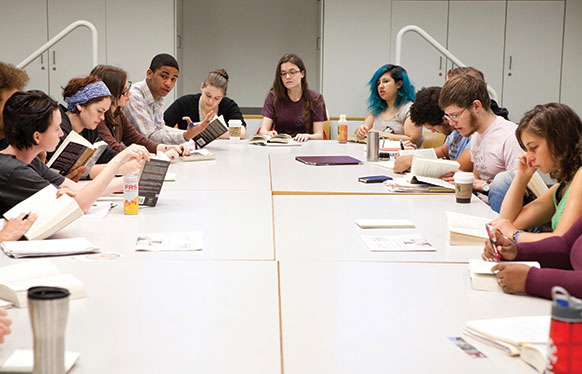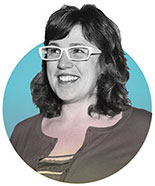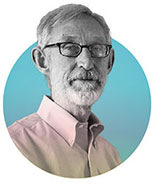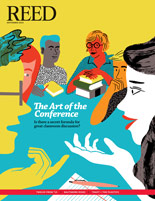
IRIS login | Reed College home Volume 94, No. 3: September 2015
The Art of the Conference (continued)

Photo by Orin Zyvan '04
Nourishing Discord
By Prof. Sarah Schaack [biology 2011–]

In my classes, our discussions center on papers from the primary scientific literature. Typically, they are very difficult—both conceptually and technically. In addition, in most cases there is a substantial foundation of previous theoretical and experimental work, much of which cannot be explained due to space constraints, upon which any given paper that we are discussing is delicately perched. Despite the difficulty presented by reading, understanding, and learning from a scientific paper at the margins of one’s knowledge, or the margins of all knowledge, this challenge is what makes such discussions joyful, productive, and rewarding. As one of my students once said, “if it wasn’t hard, it wouldn’t be any fun.”
As a conference leader, my main goal is to provide a forum for all voices. This begins by welcoming questions, many of which can be answered from evidence, but many of which cannot be answered, or cannot be answered yet. In one of my classes, I invite an author of the paper to class to participate in the discussion, thereby giving students the chance to pose their questions to the author, not the ether. This provides a window into the process of science, its communication, and the true complexity underlying the text.
Leading a discussion involves tending to the fine balance between discussants with different strengths. In any class, there are mavens who can find data and details quickly. There are also those who are great at not missing the forest for the trees. One goal of a good conference is to practice, develop, and reward people for their strengths as discussants—but another is to try and help them appreciate and develop in the areas they feel weak in. Although I rarely need to fuel the discussion, I occasionally act as translator, fact checker, framer of contexts, or provocateur. The “Author, Not Ether” series arms students for deeper and more generous discussions of texts, even when the author is not present, as is typically the case. In discussion, reading and exploring the text and the data often leads to a plurality of interpretations, disagreements, and more questions. These kinds of engagement, dissent, and controversy are a regular and positive feature of a good discussion. Nourishing discord, while maintaining an encouraging environment, is the most difficult part of leading a discussion that matters and is memorable.
A truly great conference is one where we not only unpack the study we are reading about at the moment, but go further. When we can bring our diversity of backgrounds to a specific paper and link its questions and discoveries to the broader landscape of knowledge based on the primary literature as a whole—that is a great discussion.
![]()
When It Clicks
By Prof. Douglas Fix [history 1990–]

It was mid-semester and students in my large seminar on late imperial China now knew each other’s names, as well as our expectations for each class: reading, pondering, and being prepared to discuss the assignment (R. Bachelor’s “The Seldon map rediscovered” and T. Brook’s “Gazetteer cartography of Ye Chunji”).
Four students had each prepared two discussion questions (DQs), and those questions were now in everyone’s hands. But right now, several important decisions were mine to make. Should I start with Jan’s questions? She had articulated some especially complex ideas but they might not engender active discussion. Would colleagues understand why she had asked us to imagine the Ming cartographer arguing with his literati field staff over surveying techniques? Perhaps start with Silas, a first-year student who rarely spoke in class? Would he shy away from the articulate ideas I often found in his written work if I called on him first? The order of questions on the handout seemed the most logical way to go, but Phil’s was first and he’s been overly talkative these last few meetings. Maybe start with Sarah’s #2, which referred to the maps of border regions and the paintings of frontier aborigines that we analyzed on Wednesday. I know we need that review.
As it turned out, four students had written critical summaries of the reading. Combined with the thoughtful DQs, that morning’s discussion was primed for success. Yet the fundamentals for success rely on common practices and cultivated habits. Early in the semester, we had created a set of criteria for excellent DQs. Précis assignments and my systematic guidance of reading strategies had encouraged careful, critical reading of the assignments. Seminar colleagues were familiar with each other now, and they thrived on the healthy competition that had emerged from mutual stimulation and diligent preparation. I had remembered not to assign too much reading, to keep us focused on DQ-writers’ problematics, and to guide discussion, not derail it.
And I was lucky to have Ben’s coherent and subtle explanation of a key term (Ye’s relational grid) that many did not comprehend, and Jill’s concise summary of the morning’s insights when our 50-minute class was about to end. When it clicks like this, I know why I love my job.

LATEST COMMENTS
steve-jobs-1976 I knew Steve Jobs when he was on the second floor of Quincy. (Fall...
Utnapishtim - 2 weeks ago
Prof. Mason Drukman [political science 1964–70] This is gold, pure gold. God bless, Prof. Drukman.
puredog - 1 month ago
virginia-davis-1965 Such a good friend & compatriot in the day of Satyricon...
czarchasm - 4 months ago
John Peara Baba 1990 John died of a broken heart from losing his mom and then his...
kodachrome - 7 months ago
Carol Sawyer 1962 Who wrote this obit? I'm writing something about Carol Sawyer...
MsLaurie Pepper - 8 months ago
William W. Wissman MAT 1969 ...and THREE sisters. Sabra, the oldest, Mary, the middle, and...
riclf - 10 months ago